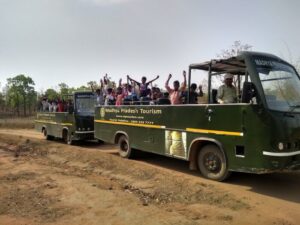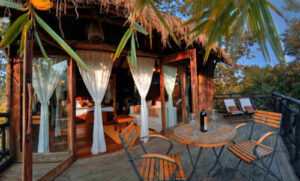Beyond the Tigers: Bandhavgarh Fort’s Historical Significance
Bandhavgarh National Park, located in Madhya Pradesh, India, is not only a haven for wildlife enthusiasts and nature lovers but also holds a rich historical and cultural significance. Beyond its diverse flora and fauna, the park is home to hidden treasures that tell tales of its fascinating past. Let’s embark on a journey to uncover the hidden gems of Bandhavgarh.
Bandhavgarh History:
The history of Bandhavgarh dates back thousands of years. It is believed to have been ruled by various dynasties, including the Mauryas, Vakatakas, Kalachuris, Baghels. The name “Bandhavgarh” translates to “Brother’s Fort,” symbolizing the deep bond between Lord Rama and his brother Lakshmana.
Bandhavgarh Fort:
Perched atop a hill within the national park, the Bandhavgarh Fort stands as a testament to its historical significance. The fort is believed to be over 2,000 years old and offers panoramic views of the surrounding landscape. Exploring the fort’s ruins takes you on a journey through time, with each stone whispering stories of the past.
Statue of Lord Vishnu in Bandhavgarh:
Within the fort complex, you will find a magnificent statue of Lord Vishnu, one of the principal deities in Hindu mythology. This intricately carved statue stands as a symbol of devotion and spirituality, adding to the spiritual ambiance of Bandhavgarh fort.
Bandhavgarh National Park, nestled in the heart of Madhya Pradesh, holds not only natural wonders but also cultural and religious significance. Within this enchanting landscape, there are references and depictions of the nine different incarnations of Lord Vishnu, showcasing the deep-rooted spiritual heritage of the region. Let’s explore these incarnations:
Matsya (Fish) Avatar:
The Matsya Avatar represents Lord Vishnu in the form of a fish. It is believed that during the great flood, Lord Vishnu took this form to save humanity and guide them to safety. References to this incarnation can be found in Bandhavgarh, symbolizing protection and divine intervention.
Kurma (Tortoise) Avatar:
The Kurma Avatar portrays Lord Vishnu as a giant tortoise. In this form, he supported the cosmic mountain during the churning of the celestial ocean. The presence of this incarnation in Bandhavgarh signifies strength, stability, and the eternal nature of divine forces.
Varaha (Boar) Avatar:
The Varaha Avatar depicts Lord Vishnu as a boar. He assumed this form to rescue the earth goddess, Bhudevi, from the depths of the ocean. The representation of Varaha in Bandhavgarh signifies the preservation and protection of the earth’s natural beauty and resources.
Narasimha (Half-Man, Half-Lion) Avatar:
The Narasimha Avatar showcases Lord Vishnu in a unique half-man, half-lion form. He incarnated in this fierce form to destroy the demon king Hiranyakashipu and restore righteousness. The presence of Narasimha in Bandhavgarh signifies courage, valor, and the triumph of good over evil.
Vamana (Dwarf) Avatar:
The Vamana Avatar represents Lord Vishnu as a dwarf Brahmin. In this form, he visited the demon king Bali and sought three steps of land, which ultimately led to the defeat of the demon and the restoration of cosmic order. References to Vamana in Bandhavgarh symbolize humility, divine intervention, and the significance of rightful balance.
Parashurama Avatar:
The Parashurama Avatar portrays Lord Vishnu as a warrior sage wielding an axe. He manifested as Parashurama to rid the world of evil and uphold righteousness. The presence of Parashurama in Bandhavgarh signifies strength, discipline, and the eradication of negative forces.
Rama Avatar:
The Rama Avatar is one of the most revered incarnations of Lord Vishnu. As the epitome of righteousness, Lord Rama embarked on a heroic journey to rescue his wife Sita from the demon king Ravana. The depiction of Lord Rama in Bandhavgarh symbolizes virtue, honor, and the victory of truth.
Krishna Avatar:
The Krishna Avatar represents Lord Vishnu in his playful and charismatic form. He appeared as Lord Krishna to guide humanity and impart divine wisdom through the sacred scripture, the Bhagavad Gita. The presence of Krishna in Bandhavgarh signifies love, compassion, and the eternal connection between the divine and mortal realms.
Kalki Avatar:
The Kalki Avatar is the final incarnation of Lord Vishnu, yet to manifest. It is believed that Lord Kalki will appear at the end of the cosmic cycle to restore righteousness and establish a new era of harmony. The reference to Kalki in Bandhavgarh symbolizes hope, renewal, and the cyclical nature of existence.
Discovering the representations of these nine incarnations of Lord Vishnu in Bandhavgarh National Park allows visitors to connect with the divine, seek spiritual solace
Temples of Bandhavgarh:
Within the fort premises, you will discover ancient temples that reflect the region’s religious and cultural heritage. These temples, dedicated to various Hindu deities, provide a serene ambiance and offer glimpses into the spiritual beliefs of the people who inhabited this area centuries ago.
Man-Made Ponds of Bandhavgarh:
Throughout Bandhavgarh, you will come across several man-made ponds, known as “talabs.” These ponds served as water sources for the fort’s inhabitants and wildlife. Rani Talab, Baba Talab, Kabir Talab, and Padam Talab are some of the prominent talabs that still exist today, adding to the park’s natural beauty.
Connections with Akbar:
Bandhavgarh has historical connections with the Mughal Emperor Akbar the Great. It is believed that Akbar gifted the fort to his general, Raja Man Singh, in the 16th century. This association adds an interesting layer of historical significance to the fort and its surroundings.
Moti Mahal and Rani Mahal:
Moti Mahal, meaning “Pearl Palace,” and Rani Mahal, or the “Queen’s Palace,” are two significant structures within the fort complex. These palaces once housed the royal families and are a testament to the architectural splendor of the bygone era.
Secret Door for Bandhavgarh Fort – Khidki:
Legend has it that a secret door, known as Khidki, was built within the fort to provide an escape route during times of danger. This hidden passage adds an air of mystery to the fort’s history and ignites the imagination of visitors.
The Legacy of Tansen:
Bandhavgarh boasts a connection with the legendary musician Tansen, one of the nine gems in Akbar’s court. It is said that Tansen spent a significant amount of time in Bandhavgarh, seeking inspiration from its natural surroundings. His presence resonates in the melodies that still echo through the land.
Kabir Das and Dharamdas Naam Sahib:
Kabir Das, one of the most revered medieval Indian poets and mystics, has a deep association with Bandhavgarh. It is believed that he spent a considerable part of his life in this region, enriching it with his spiritual teachings. Dharamdas Naam Sahib, a follower of Kabir Das.
Visiting the man-made caves of Bandhavgarh not only allows us to appreciate the ingenuity of ancient traders but also connects us to the spiritual journeys of Buddhist monks. These caves bear witness to the dynamic history of Bandhavgarh and offer a glimpse into the region’s cultural heritage, serving as a bridge between the past and the present.
In addition to its natural and historical treasures, Bandhavgarh National Park holds evidence of man-made caves that served various purposes throughout history. These caves not only provided shelter to traders but also played a role in the region’s connection with Buddhist monks. Let’s delve into the significance of these man-made caves and their connection to Bandhavgarh’s trade and Buddhist heritage.
Caves for Traders:
Bandhavgarh’s strategic location on ancient trade routes made it a hub for commercial activities. Traders traveling through the region sought shelter and protection, leading to the construction of man-made caves. These caves served as resting places for weary travelers and a safe haven for traders to store their goods. Today, some of these caves still exist, showcasing the entrepreneurial spirit and historical importance of Bandhavgarh as a trading center.
Buddhist Connections:
Bandhavgarh’s historical ties with Buddhism date back centuries. The region witnessed the presence of Buddhist monks who traveled through the area, spreading the teachings of the Buddha. It is believed that some of the man-made caves in Bandhavgarh served as meditation retreats for these monks. These caves provided a serene environment for contemplation and spiritual practice, reflecting the region’s connection to Buddhism.
Meditation Caves:
The caves associated with Buddhist monks in Bandhavgarh were specifically designed to foster a tranquil atmosphere conducive to meditation. These secluded caves, tucked away amidst the natural beauty of the park, offered an ideal setting for the monks to immerse themselves in their spiritual practices. The echoes of their devotion can still be felt within the walls of these ancient caves.
Historical Significance:
The presence of man-made caves in Bandhavgarh highlights the historical importance of the region as a crossroads for trade and cultural exchange. These caves served as meeting points for diverse communities and facilitated the exchange of goods, ideas, and knowledge. They stand as testament to the vibrant history and cultural tapestry of Bandhavgarh.
Preservation and Exploration:
Preserving and exploring these man-made caves is crucial for understanding the region’s historical and cultural heritage. Efforts should be made to protect these caves from natural degradation and human encroachment. Exploring these caves provides an opportunity to connect with the past, appreciate the craftsmanship of ancient artisans, and gain insights into the lives of traders and Buddhist monks who traversed through Bandhavgarh.
Cultural Exchange:
The presence of man-made caves in Bandhavgarh signifies the amalgamation of different cultures and their influence on the region. It is a testament to the openness and receptiveness of the people in Bandhavgarh to new ideas and traditions. The caves serve as a reminder of the rich tapestry of cultural exchange that has shaped the region over centuries.






